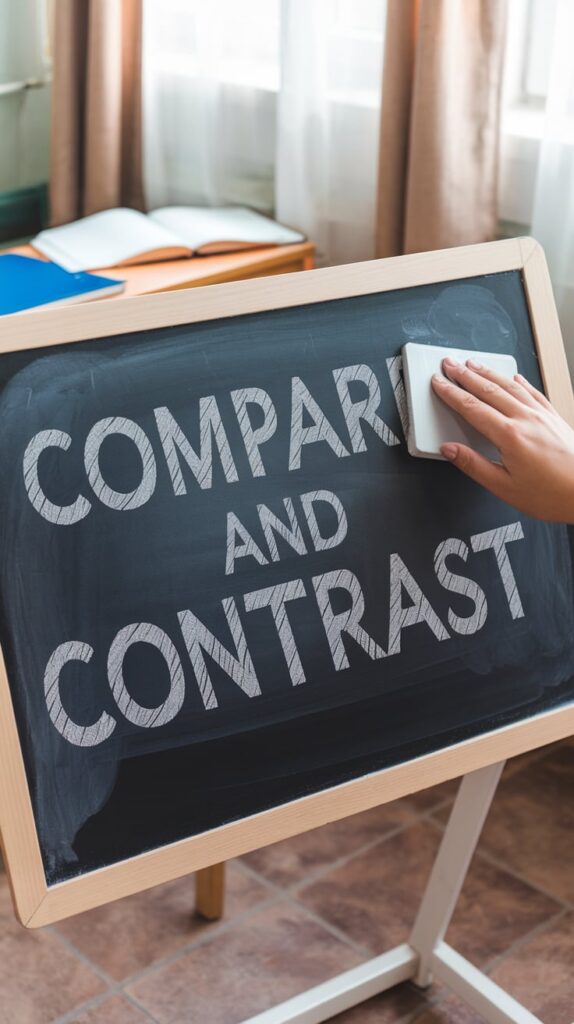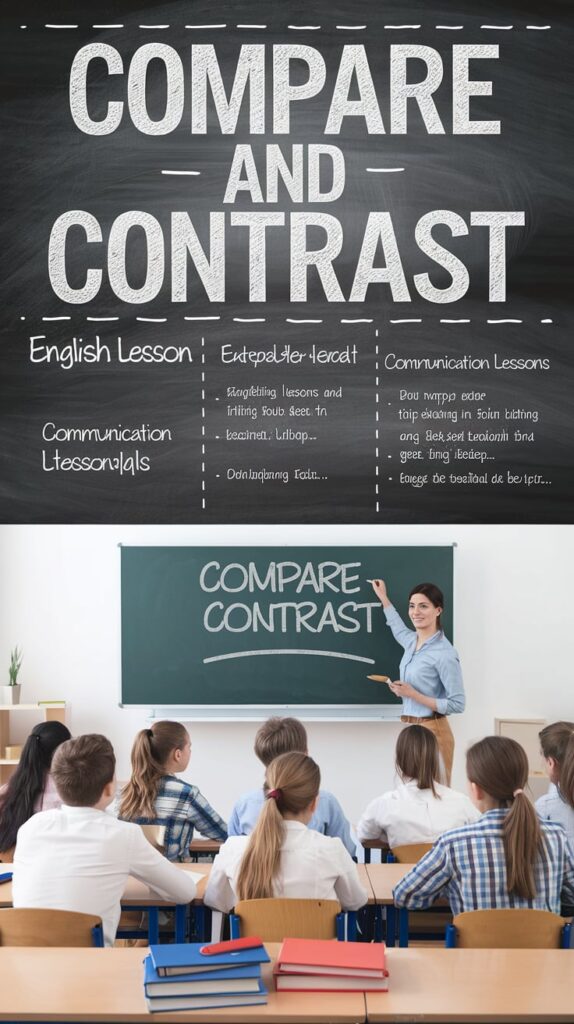In the realm of communication, understanding the concepts of compare and contrast is essential. We frequently encounter situations where we need to evaluate options, make decisions, or analyze different elements in our lives.
These two terms play a pivotal role in how we make sense of the world. By exploring their definitions, methods, and practical applications, we can deepen our understanding and enhance our critical thinking skills.
read more : Of Course or Ofcourse – Grammar Beacon
What Does the Word “Compare” Mean?
To compare is to examine two or more items for their similarities. This process helps us identify common features that may influence our opinions or decisions. When we compare, we’re essentially looking for links that unite the items in question.
Everyday Examples of Comparison
Smartphones: Consider two leading smartphones in the market. You might find that both offer high-resolution cameras, substantial storage options, and sleek designs.
By identifying these common features, you can better understand which phone might meet your needs.
Books: When comparing novels, you might focus on themes, character development, and writing style. For instance, both a romance novel and a thriller might explore human relationships, allowing you to appreciate their similarities despite different genres.
Vacation Destinations: If you’re considering a beach getaway versus a mountain retreat, you might compare the activities available, like water sports versus hiking. While the environments differ, both can offer relaxation and adventure.

What Does the Word “Contrast” Mean?
To contrast involves examining items for their differences. This process emphasizes unique characteristics that set items apart from one another. By understanding these distinctions, we can make more informed decisions.
Everyday Examples of Contrast
Smartphones: Continuing with the smartphone example, you might note that while both phones have excellent cameras, one operates on iOS and the other on Android. This fundamental difference can greatly influence your user experience.
Books: If you were to contrast two novels, you might examine the narrative structure. One book might use a linear timeline, while the other employs flashbacks. Such differences affect how stories unfold and engage readers.
Cars: When considering two vehicles, you might contrast an electric car with a gasoline-powered one. The electric car could be quieter, more environmentally friendly, and cost-effective in terms of fuel,
while the gasoline car might have a longer driving range and faster refueling times.
read more : Pickup or Pick Up – Grammar Beacon

Compare vs Contrast: Definitions, Differences, and Examples
Understanding the differences between comparison and contrast can significantly improve your analytical skills. Let’s break down their definitions and key aspects.
Purpose
Compare: The primary purpose of comparing is to highlight similarities. This is particularly useful when you want to see how different items align in terms of features or qualities.
Contrast: In contrast, the primary purpose is to emphasize differences. This helps clarify how items diverge, which can be critical when making decisions based on distinct needs or preferences.
Focus
Compare: The focus during a comparison is on shared characteristics. For instance, when assessing two job offers, you might look at salary, benefits, and work-life balance. Identifying these commonalities can help you weigh your options effectively.
Contrast: The focus during a contrast is on unique characteristics. In the job offer example, you might note how one company offers remote work options while the other emphasizes a collaborative office environment.
read more : “Totalling” vs. “Totaling”: Navigating the Spelling Dilemma – Grammar Beacon
Method
Compare: When comparing, you might create a Venn diagram to visualize the common features and overlaps between items. This method allows for a clear representation of similarities.
Contrast: To effectively contrast items, you could use a side-by-side table to illustrate their unique attributes. This format makes it easier to see the distinct features that set the items apart.
Examples in Context
Let’s dive deeper into practical contexts where comparison and contrast come into play.
Compare
Smartphones: When comparing the iPhone 14 and the Samsung Galaxy S22, you might highlight their similarities in camera quality and processing speed. Both phones excel in photography, providing users with vibrant images.
Restaurant Menus: If you’re choosing between two Italian restaurants, you might compare their offerings. Both could feature classic dishes like pasta, pizza, and tiramisu, allowing you to appreciate their shared culinary heritage.
Online Courses: Imagine evaluating two online graphic design courses. You may find that both programs offer similar content, such as Adobe software training and project-based learning. These similarities can help you decide which course fits your learning style better.
read more : Scrapped vs Scraped – Grammar Beacon

Fitness Programs: When comparing yoga and Pilates, both focus on body strength, flexibility, and mindfulness. These common aspects highlight their shared goals of improving physical and mental well-being.
Contrast
Vacation Destinations: Contrasting a vacation in Bali with one in Aspen can reveal significant differences. Bali offers tropical beaches and cultural experiences, while Aspen boasts snowy mountains and skiing. This contrast can help you decide based on your preferred climate and activities.
Books: If you were to compare George Orwell’s 1984 with Jane Austen’s Pride and Prejudice, you might focus on contrasting themes.
1984 tackles dystopian governance and surveillance, whereas Pride and Prejudice explores societal norms and personal relationships.
Cars: When evaluating a hybrid vehicle against a traditional gasoline car, you can contrast their environmental impacts, fuel efficiency, and maintenance costs.
The hybrid is generally better for the environment, while the gasoline car may offer more power and quicker refueling options.
Clothing Brands: If you were to contrast two clothing brands, such as Patagonia and Zara, you might note differences in their sustainability practices and target markets. Patagonia focuses on eco-friendly materials, while Zara emphasizes fast fashion trends.
read more : Excel or Accel – Grammar Beacon
Synonyms of “Compare” and “Contrast”
Understanding synonyms can enhance your vocabulary and improve your communication skills when discussing these concepts.
Synonyms of “Compare”
- Assess: To evaluate the qualities or characteristics of items.
- Evaluate: To judge the value or importance of items based on certain criteria.
- Juxtapose: To place items side by side for comparison.
- Match: To find similarities between two or more items.
- Weigh: To consider the pros and cons of items against each other.
Synonyms of “Contrast”
- Differentiate: To identify the differences between items.
- Distinguish: To recognize or ascertain what makes items unique.
- Diverge: To move away from a common point; highlighting differences.
- Oppose: To place in contrast to something, emphasizing differences.
- Counter: To provide a contrasting response or argument.
Origins of the Words “Compare” and “Contrast”
Understanding the origins of words can enrich your comprehension of their meanings.
Origins of the Word “Compare”
The term compare originates from the Latin word comparare, which means “to pair together.” This origin reflects the fundamental nature of comparing—bringing items together to identify similarities.
Origins of the Word “Contrast”
The word contrast comes from the Latin contrastare, meaning “to stand against.” This etymology highlights the idea of examining differences and distinguishing characteristics.

The Importance of Comparing and Contrasting
Understanding how to effectively compare and contrast is essential in various aspects of life. Here are some key reasons why these skills are valuable:
Decision-Making
When faced with choices, whether in personal or professional contexts, comparing and contrasting options allows you to make informed decisions. By identifying similarities and differences, you can weigh the pros and cons of each option.
Critical Thinking
Engaging in comparison and contrast encourages critical thinking. It requires you to analyze items deeply, recognize patterns, and draw meaningful conclusions. These skills are invaluable in academic settings and beyond.
Communication
Using comparison and contrast in communication can enhance clarity. When explaining complex ideas or arguments, highlighting similarities and differences helps your audience grasp your message more effectively.
Problem Solving
In problem-solving scenarios, comparing and contrasting potential solutions can illuminate the best course of action. By evaluating various options, you can identify the most effective approach.
Practical Tips for Effective Comparison and Contrast
To make the most of your comparison and contrast efforts, consider the following practical tips:
Be Clear About Your Purpose
Before you start comparing or contrasting, define your goal. Are you trying to make a decision, analyze data, or simply explore relationships? A clear purpose will guide your analysis.
Organize Your Thoughts
Utilize tools like Venn diagrams, tables, or charts to organize your comparison and contrast efforts. Visual aids can simplify complex information and make it more digestible.
Use Specific Examples
When making comparisons or contrasts, provide specific examples to illustrate your points. This adds clarity and makes your analysis more relatable.
Consider Multiple Perspectives
When comparing or contrasting, consider multiple perspectives. This enriches your analysis and can lead to more nuanced conclusions.

Revise and Reflect
After completing your comparison or contrast, take a moment to revise and reflect. Did you capture all relevant aspects? Are there additional similarities or differences you might have missed?
Real-World Applications of Comparison and Contrast
The concepts of comparison and contrast find applications in numerous fields. Here are a few notable examples:
Education
In educational settings, teachers often encourage students to compare and contrast different literary works, historical events, or scientific theories. This approach promotes deeper understanding and critical analysis.
Marketing
In marketing, businesses frequently compare their products to competitors to highlight advantages. Effective advertising often emphasizes unique features that set a product apart from the rest.
Research
Researchers often compare and contrast different studies to synth
esize findings. This method allows them to identify trends, gaps, and areas for further exploration.
Everyday Life
In daily life, we constantly compare and contrast options. Whether selecting a restaurant, choosing a movie, or deciding on a new car, these skills help us navigate choices effectively.
Conclusion
Understanding the meanings of compare and contrast is essential for effective communication, decision-making, and critical thinking. By recognizing similarities and differences, we can navigate our choices more confidently and articulate our thoughts more clearly.
As you encounter various situations—be it in choosing between two smartphones, analyzing literature, or evaluating job offers—remember the value of comparing and contrasting. By honing these skills, you’ll enhance your ability to think critically, communicate effectively, and make informed decisions.
Sources
- Merriam-Webster Dictionary
- Oxford English Dictionary
- Educational resources on comparison and contrast strategies
- Psychology Today articles on decision-making and critical thinking
Incorporating the principles of comparison and contrast into your everyday life will help you make better choices and understand the world around you with greater clarity. So, the next time you’re faced with a decision, take a moment to compare and contrast your options—your future self will thank you!

James Logan is a seasoned blogger and language enthusiast behind Grammar Beacon. With years of experience in grammar and writing, James shares his expertise through insightful and engaging content. His passion for clear communication and linguistic precision shines in every post, making complex grammar concepts accessible and enjoyable for readers. Follow James for expert advice and tips to refine your writing skills.







